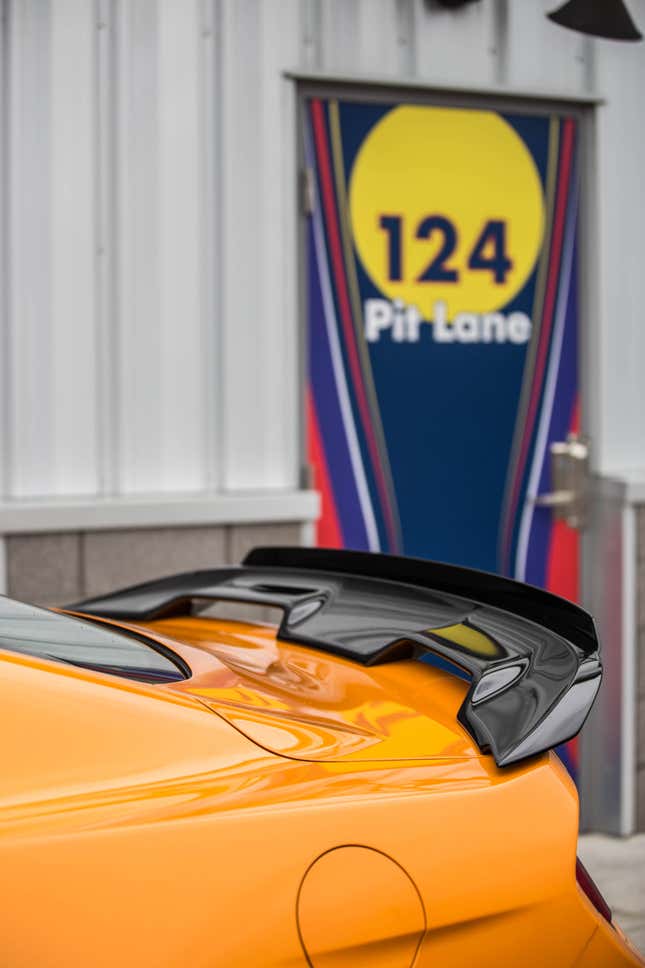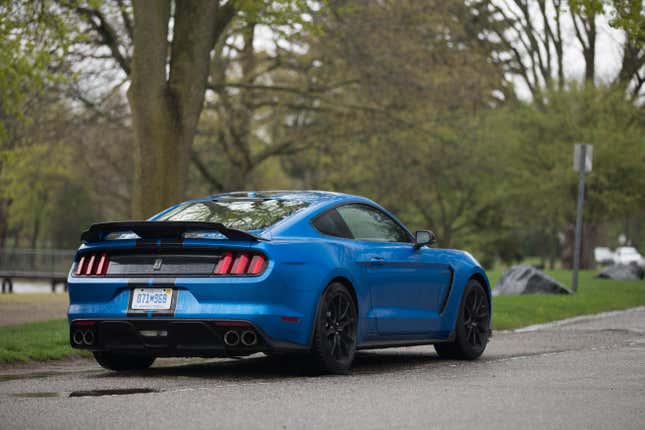Once the nose of the 2019 Ford Mustang Shelby GT350 was pointed down the main straight of M1 Concourse, I mashed the throttle to the floor. All usual things happened—forceful acceleration, more noise, that floaty sensation behind my navel—but then something different did, too.
The rev needle kept climbing, climbing, climbing. Instinct told me that I should have upshifted long ago, but here I was screaming toward 8,000 RPM with the engine still feeling like it had plenty left to give. This was spooky. This was incredible.
(Full Disclosure: Ford flew me up to Detroit for a day to try out the 2019 Shelby GT350. It paid for my hotel, food, booze and rented out the M1 Concourse for us to use. Also, it bought me some Claritin for my allergies.)
The 2019 GT350 isn’t super different from the 2016 model in that it still keeps the Voodoo engine. Ford only made changes to the car’s handling and aerodynamic bits for the 2019 version. Because why fix what isn’t broken, right?
What Is It?
In terms of hierarchy, the Shelby GT350 sits above the Mustang GT with the Performance Pack 2. It’s the track-intended Mustang and the biggest difference between the two lies in the engine. The Mustang GT uses Ford’s 5.0-liter Coyote V8 engine, while the GT350 is equipped with the Voodoo.
The Voodoo is a godly, 5.2-liter, naturally aspirated, flat-plane crankshaft V8. Its design allows it to rev higher and faster than the cross-plane crankshaft engines that are common in many other cars—and it’s generally louder. Noise is always a good thing, especially when coming from a free-breathing V8.
Flat-plane V8s are usually found in race cars and expensive exotics like Ferraris and McLarens, so it’s actually pretty cool that you can get one in a Mustang and not completely wreck your savings account.
Specs That Matter
Power in the 2019 GT350 remains unchanged, not that it needed any more. It produces a claimed 526 horsepower and 429 lb-ft of torque, all of which is hooked up to a Tremec six-speed manual transmission. What did change (albeit slightly) is how the GT350 now puts down that power.
Ford had Vehicle Dynamics Supervisor Keith Weston on hand during the launch, so I sat down with him to learn some more about car.
For 2019, Michelin designed a set of GT350-specific Pilot Sport Cup 2 tires with more exaggerated contact surface ratios to increase longitudinal and lateral grip. So Ford improved the aero—closing off a bit of the front grille to reduce front lift and dropping the drag coefficient. (Apparently by about .010, if you were curious.)

On the rear, the spoiler was revamped to increase downforce. And customers now have the option of using the new Gurney flap that detaches or reattaches by a matter of four bolts.
As our own David Tracy reported last June, the MagneRide dampers were also adjusted:
... re-tuning for the new damper inputs (which have changed from the outgoing model year’s thanks to the revised tires) involved adjusting how much current goes into the coils in the damper under differing driving conditions. This changes the magnetic field created, and alters how “tight” the bond is among the ferrous particles in the damping fluid, thus changing the stiffness of the shock.
“So, the system’s got information from acceleration direction, yaw information, wheel-spin, wheel speed, vertical lateral longitudinal acceleration data,” Weston listed off. “We’re able to use that to determine what damping characteristics we want for those conditions. The vehicle can very quickly respond to that information and adjust the level of damping to make it optimal for the condition,” he explained.
(I asked a Ford rep if the newly calibrated shocks could be applied to the 2016 GT350 models and he said that he couldn’t see why not.)

The ABS software was re-tooled as well. Typically, anti-lock brakes are there to help you steer the car while braking. But for the purpose of tuning a performance car, Ford wanted to maximize the car’s ability to not only turn while braking, but also do it with as much stability as possible.
“You can’t just change one component in the system without developing the rest of the system around,” Weston said. “The tires are a big enabler with the changes that the car underwent. We got the new tire and we developed the rest of the system to work with the tire.”
“[The GT350] very easy to drive fast,” he concluded flatly. “It rewards the driver and it’s all part of making it a fun experience. I’ve driven plenty of fast cars that weren’t fun. This is a fast car that’s also fun.”
He’s right.
What’s Great

Because we live in a crazy, power-hungry world, 526 HP barely raises any eyebrows anymore. Why would it, when you’ve got Corvettes and Hellcats and Demons that make over 700? But how that 526 HP is put down is what makes all the difference.
Some of the fat-power German cars I’ve driven recently feel like they are operating from under a deep sleep. The motions and momentum are there, but the sensations are always dulled and muted beneath layers of NVH padding and luxury touches.
The Mustang, conversely, is the loud, brash, unrefined and thrash-happy alternative. It thunders down into braking zones, rips through corners and screams like a banshee back out onto the straights. The noise alone is enough to split stone.
Power delivery is incredibly linear and it just—keeps—on—revving. The GT350 redlines at 8,250 RPM and revving it out is truly like leaping up to touch the sky. M1 is a smaller track and the car’s gears are long, so it was perfectly happy doing the whole thing in third.
But when it came to it, the act of shifting alone was a joy. The shifter is short and the gates are crisply cut. You need to put a little force behind each throw before the lever finds its way into the housing with a satisfying metallic clunk.
The steering is nice and heavy, but not the artificially added weight other cars apply to make things feel “sportier.” It was substantive, like there was a reason for the heaviness. At no point did I not know where the nose was pointed or what was going on with the front tires. There was zero play in the wheel off-center. Even the smallest movements from my hands flicked down to the tires.

Grip, too, was ever-present. Bursts of acceleration were put down neatly, while the sticky tires sank their claws ferociously into the pavement in the corners to slingshot the car around for the next apex.
All of these factors—linear power, acute steering, unrelenting grip—resulted in one thing: Confidence. Everything worked so well in symphony with everything else that I didn’t need to think about them again once I understood them. No surprises. No spooks. Which meant that I could focus on pushing my own limits a little more, learning the track and perfecting my line.
Cars are kind of funny like that. The better they are, the less you have to think about them. The less you need to compensate for certain shortcomings. Once that happens, then finding the limit all comes down to you.
What’s Weak

On the track, the GT350 is a star. But on Michigan’s pothole-ridden roads, it’s less than stellar. Don’t get me wrong, it’s perfectly daily drivable, but you’ll be extremely aware that you’re riding on a performance suspension system.
Even in the most casual driving mode, the GT350 rides hard, is loud and has heavier steering. But since I’m a masochist and I enjoy that type of thing, it didn’t bother me too much. The hard suspension might shake the drink out of your cup if you’re not careful, though.
And because it wears 295-section front tires, tramlining—a phenomenon where a car’s wheels tend to follow the road surface—is a noticeable thing. Can’t be helped, you just have to deal with it.
A Ford rep told me that a lot of work went into making the car ride comfortably as a daily. I wouldn’t call it uncomfortable exactly, but the ride quality is something that a friend who knows nothing about cars might bring up because they noticed it.
One of the downsides you read about flat-plane V8s is the added vibration because of imbalance issues. Personally, I didn’t notice more vibration than what you’d get in a normal Mustang, both while doing some around-town driving and sitting at stoplights. Weston said that the company apparently “did a lot of things to minimize vibration.”
Whatever they did seems to have paid off.
Early Verdict
Here’s the thing: The GT350 may be the next step up from the Mustang GT with the Performance Pack 2, but it also costs a whopping $20,000 more. That’s a lot of money no matter which way you look at it—and it’s especially a lot when you still end up with a Mustang that has eight cylinders, six gears and only 66 more horsepower.
Yet, the gains of the GT350 aren’t quite linear to dollar amounts.
Having driven both on a track, I can say that the GT350 feels like a better and improved version of the Mustang GT PP2. The GT PP2 is quite excellent in its own right, but it does sort of feel like it uses performance parts that were added as an afterthought.
The GT350’s performance prowess feels just a little more inherent, a little more holistic, like it had been built from the ground up with the track in mind. It handles better than ever now, comes exclusively with a six-speed manual and is the only car on this side of a Ferrari where you can get a naturally aspirated flat-plane V8. To some, the engine alone is worth it.
The critics are right, the GT350 is a Mustang. Undoubtedly, though, it’s a Mustang that is most certainly a future classic. Up to you to decide if it’s worth it or not.